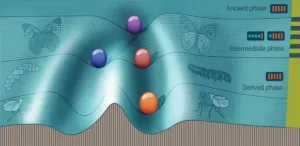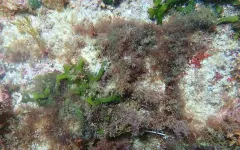(Press-News.org) The Gulf of Mexico holds huge untapped offshore oil deposits that could help power the U.S. for decades.
The energy super basin's longevity, whose giant offshore fields have reliably supplied consumers with oil and gas since the 1960s, is the result of a remarkable geologic past - a story that began 200 million years ago among the fragments of Pangea, when a narrow, shallow seaway grew into an ocean basin, while around it mountains rose then eroded away.
The processes that shaped the basin also deposited and preserved vast reserves of oil and gas, of which only a fraction has been extracted. Much of the remaining oil lies buried beneath ancient salt layers, just recently illuminated by modern seismic imaging. That's the assessment of researchers at The University of Texas at Austin, who reviewed decades of geological research and current production figures in an effort to understand the secret behind the basin's success.
Because of its geological history, the Gulf of Mexico remains one of the richest petroleum basins in the world. Despite 60 years of continuous exploration and development, the basin's ability to continue delivering new hydrocarbon reserves means it will remain a significant energy and economic resource for Texas and the nation for years to come, said lead author John Snedden, a senior research scientist at the University of Texas Institute for Geophysics (UTIG).
"When we looked at the geologic elements that power a super basin - its reservoirs, source rocks, seals and traps - it turns out that in the Gulf of Mexico, many of those are pretty unique," he said.
The research was featured in a December 2020 special volume of the American Association of Petroleum Geologists Bulletin focused on the world's super basins: a small number of prolific basins that supply the bulk of the world's oil and gas.
According to the paper, the geologic elements that have made the Gulf of Mexico such a formidable petroleum resource include a steady supply of fine- and coarse-grained sediments, and salt: thick layers of it buried in the Earth, marking a time long ago when much of the ancient sea in the basin evaporated.
Geologically, salt is important because it can radically alter how petroleum basins evolve. Compared to other sedimentary rocks, it migrates easily through the Earth, creating space for oil and gas to collect. It helps moderate heat and keeps hydrocarbon sources viable longer and deeper. And it is a tightly packed mineral that seals oil and gas in large columns, setting up giant fields.
"The Gulf of Mexico has a thick salt canopy that blankets large portions of the basin and prevented us for many years from actually seeing what lies beneath," Snedden said. "What has kept things progressing is industry's improved ability to see below the salt."
According to the paper, the bulk of the northern offshore basin's potential remains in giant, deepwater oil fields beneath the salt blanket. Although reaching them is expensive and enormously challenging, Snedden believes they represent the best future for fossil fuel energy. That's because the offshore -- where many of the giant fields are located -- offers industry a way of supplying the world's energy with fewer wells, which means less energy expended per barrel of oil produced.
Snedden said there is still much to learn about hydrocarbons beneath the Gulf of Mexico, how they got there and how they can be safely accessed. This is especially true in the southern Gulf of Mexico, which was closed to international exploration until 2014. One of the few publicly available datasets was a series of UTIG seismic surveys conducted in the 1970s. Now, a wealth of prospects is emerging from new seismic imaging of the southern basin's deepwater region.
"When you look at recent U.S. oil and gas lease sales, Mexico's five-year plan, and the relatively small carbon footprint of the offshore oil and gas industry, I think it's clear that offshore drilling has an important future in the Gulf of Mexico," Snedden said.
INFORMATION:
Snedden's research was conducted within UTIG for the Gulf Basin Depositional Synthesis project (which he directs). The project has been continuously funded by an industry consortium since 1995. UTIG is a unit of the Jackson School of Geosciences.
MADISON, Wis. -- The demand for COVID-19 vaccines continues to outpace supply, forcing public health officials to decide who should be first in line for a shot, even among those in the same pool of eligible vaccine recipients.
To assist these efforts, researchers at the University of Wisconsin School of Medicine and Public Health and UW Health have developed a tool that incorporates a person's age and socioeconomic status to prioritize vaccine distribution among people who otherwise share similar risks due to their jobs. The tool helps identify those who are at greater risk of severe ...
WHAT:
Scientists studying the body's natural defenses against bacterial infection have identified a nutrient--taurine--that helps the gut recall prior infections and kill invading bacteria, such as Klebsiella pneumoniae (Kpn). The finding, published in the journal Cell by scientists from five institutes of the National Institutes of Health, could aid efforts seeking alternatives to antibiotics.
Scientists know that microbiota--the trillions of beneficial microbes living harmoniously inside our gut--can protect people from bacterial infections, but little is known about how they provide protection. Scientists are studying the microbiota with an eye to finding or enhancing natural treatments to replace antibiotics, which ...
A new study, led by a theoretical physicist at the U.S. Department of Energy's Lawrence Berkeley National Laboratory (Berkeley Lab), suggests that never-before-observed particles called axions may be the source of unexplained, high-energy X-ray emissions surrounding a group of neutron stars.
First theorized in the 1970s as part of a solution to a fundamental particle physics problem, axions are expected to be produced at the core of stars, and to convert into particles of light, called photons, in the presence of a magnetic field.
Axions may also make up dark matter - the mysterious stuff that accounts for an estimated 85 percent of the total mass of the universe, yet we have so far only seen its gravitational effects on ordinary matter. Even if the X-ray excess turns out not to be ...
Computer simulations of cells evolving over tens of thousands of generations reveal why some organisms retain a disused switch mechanism that turns on under severe stress, changing some of their characteristics. Maintaining this "hidden" switch is one means for organisms to maintain a high degree of gene expression stability under normal conditions.
Tomato hornworm larvae are green in warmer regions, making camouflage easier, but black in cooler temperatures so that they can absorb more sunlight. This phenomenon, found in some organisms, is called phenotypic switching. Normally hidden, this switching is activated in response to dangerous genetic or environmental changes.
Scientists have typically studied this ...
Scientists at the Institute of Physics of the University of Tartu have found a way to develop optical quantum computers of a new type. Central to the discovery are rare earth ions that have certain characteristics and can act as quantum bits. These would give quantum computers ultrafast computation speed and better reliability compared to earlier solutions. The University of Tartu researchers Vladimir Hizhnyakov, Vadim Boltrushko, Helle Kaasik and Yurii Orlovskii published the results of their research in the scientific journal Optics Communications.
While in ordinary computers, the units of information are binary digits or bits, in quantum computers the units are quantum bits or qubits. In an ordinary computer, information is mostly ...
Tsukuba, Japan - Out with the old, in with the new, as the New Year's saying goes, but not where the marine environment is concerned. Researchers from Japan have discovered that ocean acidification keeps algal communities locked in a simplified state of low biodiversity.
In a study published on 11th January 2021 in Global Change Biology, researchers from the University of Tsukuba have revealed that as oceanic carbon dioxide levels rise, the biodiversity and ecological complexity of marine algal communities decline.
Ocean acidification is the continuing increase in the acidity of the Earth's oceans, caused by the absorption of atmospheric carbon dioxide (CO2). ...
The celebrations in the 250th anniversary of the birth of Ludwig van Beethoven would not be the same without Herbert von Karajan's brilliant performances conducting Beethoven's memorable symphonies. The execution of any musical symphony is a hugely difficult task, demanding very significant skills on the part of each individual musician - but perhaps the most difficult task lies with the conductor who has to orchestrate the musicians into making the music cohesively come alive and speak to our deepest emotions.
In many ways the human brain is like an orchestra, where different regions perform very different types of processing, such ...
A new study conducted at the University of Turku, Finland, shows that patients with a schizophrenia spectrum disorder have an increased risk of Parkinson's disease later in life. The increased risk may be due to alterations in the brain's dopamine system caused by dopamine receptor antagonists or neurobiological effects of schizophrenia.
The record-based case-control study was carried out at the University of Turku in collaboration with the University of Eastern Finland. The study examined the occurrences of previously diagnosed psychotic disorders and schizophrenia in over 25,000 Finnish Parkinson's disease (PD) patients ...
Tsukuba, Japan - A team of researchers lead by the University of Tsukuba have created a new theoretical model to understand the spread of vibrations through disordered materials, such as glass. They found that as the degree of disorder increased, sound waves traveled less and less like ballistic particles, and instead began diffusing incoherently. This work may lead to new heat- and shatter-resistant glass for smartphones and tablets.
Understanding the possible vibrational modes in a material is important for controlling its optical, thermal, and mechanical properties. The propagation of vibrations in the form of sound of a single ...
Scientists of Tomsk Polytechnic University jointly with colleagues from the University of Lille (Lille, France) synthetized a new material based on reduced graphene oxide (rGO) for supercapacitors, energy storage devices. The rGO modification method with the use of organic molecules, derivatives of hypervalent iodine, allowed obtaining a material that stores 1.7 times more electrical energy. The research findings are published in Electrochimica Acta academic journal (IF: 6,215; Q1).
Photo: modified rGO supercapacitor electrodes
A supercapacitor is an electrochemical device for storage and release ...





